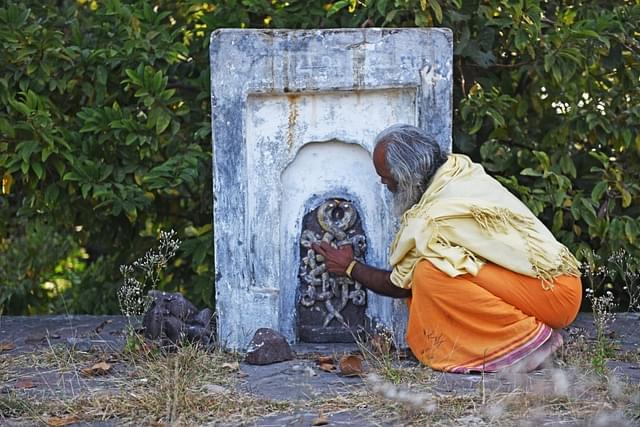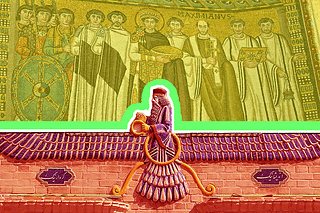Magazine
The Serpent: Fear And Fascination
Aravindan Neelakandan
Aug 01, 2018, 03:07 PM | Updated 03:06 PM IST
Save & read from anywhere!
Bookmark stories for easy access on any device or the Swarajya app.

The monsoon in India brings out the snakes. They have a primordial relation to humans. Every human culture has feared the snakes and has equally admired them. The venom is only one aspect of the animal. Its ability to renew its skin along with its deadly venom has combined in the snake the symbols of life and death. Evolutionary psychologists point out that the snakes provided a vital selection pressure in the emergence of modern human species. So the deep fascination was old when human civilisation was young. When humanity entered the agricultural age, along with the celestial cycles, the cycles of monsoon also became important. The skin-renewing cycle of the snake now became the symbol of earth-based fertility. The ecological significance of snakes soon became a part of common knowledge. The farming cultures further observed the fact that the monsoons, which are the life support for agricultural civilisations, also brought out the snakes.
In India, which has had an unhindered evolution and diversification of natural religion and earth-based spiritual traditions, the snakes have become an integral part of the culture. All our deities are associated with the serpent. On the fifth day of the monsoon month Srvana, we celebrate Naga Panchami, where we worship serpents. They are now more than our reptilian cousins in the phylogenetic tree. They shape our human age both on the outer and the inner realms.
Say ‘serpent’ and two conflicting imageries come before our minds. In one, the serpent is energy, a mysterious energy, related to earth and to human consciousness, and in the other, the serpent is the arch enemy of humanity. The first imagery is, of course, related to kundalini and the second, to the Christian theological view of the Hebrew Bible. In between are the various shades of colours present in the hood of the serpent.
There is a need to emphasise the subtle difference between the snake and the serpent. Anthropologist Balaji Mundkur points out that while the snake is 'a mere zoological entity', 'serpent opens up vast metaphorical possibilities’. Similarly, the terms naga and sarpa’ though both are related to the snake, and are used for quite a long time interchangeably, have a difference. Bibek Debroy, economist and Indologist, while discussing the difference, says that the sarpas and nagas seem to be differentiated in two ways. One is that nagas can assume human forms and they have separate geographical habitations.
Serpents have always fascinated humanity. They have been as venerated and worshipped by humanity as they have been feared and despised. In most human cultures, these two sets of responses have run concurrently. In natural religions across the world, the serpent veneration has been well integrated into their cultures and societies. When religions of expansionist monotheism encountered these native religions, they mapped the serpent veneration to their own negative mythology of the serpent and characterised it as a worship of the devil.
In the native religions of which the only remaining living one is Hinduism, serpents symbolise both earth energy and sex energy as well as the pathway through which the process of self-realisation takes place. This tradition can be glimpsed today in certain Western traditions like Kabbalah and in what remains of the native American religion. However, if one is to understand the complete nature of serpent veneration and witness its evolution through the millennia, then one needs to look towards India. It is a living, vibrant tradition here.
The relation between serpent and the quest for knowledge and immortality, which is seen in ancient natural religions, include the vedic forms, the substratum on which tantric traditions evolved in India. Though it has also manifested in the mystic traditions of the West like Jewish Kabbalah and hermetic traditions, this evolution has been totally unhindered in Indian tradition than anywhere else. Particularly in Christendom, they were subjected to severe persecution and driven to the margins. Today, the well-known tantra which relates the goddess with the serpent has very deep origins.
Knowledge And Immortality: Serpents In Vedic Tradition
Archeologist M C Joshi had pointed out in his 2012 paper on the origins of tantra that the then recent excavations in the Bannu district of Pakistan had brought out female figurines “showing affiliations with a snake goddess” dated 4000 to 3500 BCE. Then, in the excavations carried out in Harappan sites, particularly in the Gumla Valley of the North-West Frontier region of Pakistan, the number of snake goddess figurines obtained dated to a period not less than 2500 BCE, which made archaeologist A H Dani call it as 'serpent worshippers culture'.
In vedic literature, agni is considered as the ‘furious serpent’ (RV I.79.1). And soma is likened to the serpent “Ahi crawling out of his old skin” (RV 9.86.44). Satapatha Brahmana declares Veda itself as sarpa-vidhya or serpent knowledge (13.4.3.9).
In a detailed study of the hymns and stories related to soma ritual, Ananda Coomeraswamy sees Apala, the daughter of the sun, appearing “in the likeness of a serpent and that the ritual itself represents shape-changing” and the result is that “the complexion of the goddess or snake shines as bright as the sun”. Here, the daughter of the sun goes through the solar wheel and sheds her scaly skin for the solar skin (siirya-tvacam – RV 8.91.)
In Valmiki’s Ramayana, Hanuman encounters Surasa the mother of nagas (Nagamata) as he flies over the ocean in search of Sita. We are told that Surasa could take any form she likes and none could cross the ocean zone where she resides without entering her mouth. Hanuman fulfils her obligation intelligently and is blessed by her. She is addressed by Hanuman respectfully as Dakshayani, the daughter of Daksha. She is, thus, also the sister of Sati. While Sati-Shiva marriage led to a bitter rivalry between Shiva and her father, Surasa was given in marriage to Kashyapa along with 12 of his other daughters. And this included both Kadru and Vinata.
In Mahabharata as well as in the puranas, Kadru gives birth to a thousand serpents, who in turn become the forefathers of all the serpents in the world, while Vinata who was tricked into slavery by Kadru and her sons, gave birth to Garuda, the arch-enemy of serpents, and Aruna, the charioteer of the sun. The serpents demanded that the nectar of immortality belonging to the devas be brought to them and Garuda had to oblige, and yet deceived them through a trick. A few drops of nectar fell on the durba grass (desmostachya bipinnata). When the snakes tried to lick it in vain, the grass made their tongues forked. This whole ithihasic and puranic narrative relates back to the Rig Vedic hymns, where the falcon is the soma thief. Mahabharata also describes the nectar pot being placed on a wheel guarded by the serpents. Here, Garuda battles the celestial serpents and takes away the nectar for terrestrial serpents only to deceive the latter, later. The wheel and the serpents relate to the vedic Apala who goes through the solar wheel.
In Bhagavad Gita, Krishna declares that among the sarpas he is Vasuki and among the nagas he is Ananta (BG: 10:28-29). Debroy points out that both Vasuki and Ananta are brothers – sons of Kadru. So, one has to conclude that even though sarpas and nagas are distinct categories, they are related, diversifying from a common origin.
The relation between the serpent and the quest for immortality also appear in the distant epic of Gilgamesh. In this oldest epic recorded in cuneiform writing almost 4,000 years ago, the hero battles animals and gets to the plant of immortality, only to be deprived of it by the serpents. A Harappan seal relates the hero battling the animals to the Gilgamesh seal (but in the Indic way by including an elephant) while also showing a solar wheel. In the Hebrew Bible, the serpent beguiles Eve into eating the ‘fruit of knowledge’ with the promise of immortality, leading to the exile of humans from the Garden of Eden – a kind of alienation from the rest of the biological realm.
The one common theme that runs through all these traditions is the association of the serpent with a secret, sacred knowledge of immortality. Later, this connection between serpent, knowledge and immortality would be explored in all their richness by the Indian civilisation, even as they got destroyed or marginalised in other cultures.
Serpents In Buddhism
The nagas are perceived by Buddhism ambiguously. Mahavagga’s Pali Vinaya text says Buddha refused ordination to a naga. In an unusually harsh tone, he tells the nagas that they are incapable of spiritual growth in his dhamma and only if they practise fasting on certain days in their next birth they would be born as humans after which they could be admitted into the sangha. After the naga leaves, Buddha cautions his disciples against the nagas saying that the serpents that take human form should not be admitted into the sangha. This is despite the fact that it was naga king Muchalinda, who provided protection to Buddha when he was meditating.
Slowly, Buddhism came to accept the nagas only after they were subjugated and accepted the dhamma. For example, Apalala, the serpent king being threatened by Indra and then being accepted by Buddha, is depicted in the stone reliefs of Nagarjunakonda. Yet, the Buddhist perception of nagas as inferior beings persisted well into later centuries. In a quasi-historical legend about the Ramagrama Stupa, it is said that the serpent guardian of the lake near the stupa, which contained the sacred relic of Buddha, appeared before emperor Ashoka when he tried to take and relocate the relic, and stopped him. The serpent told Ashoka that because of his evil karma he had received the inferior body of the naga, and now by offering service to Buddha, he has cleansed himself of the evil karma. Chinese pilgrim Hsuan-tsang informs us that at the spot where the naga emerged from the lake, an inscription describing the above incident was placed.
In later Buddhism, the Garuda-serpent animosity is portrayed dramatically and they are brought into harmony by Buddhist principles. This is shown in the famous Sanskrit drama Nagananda of emperor Harsha (seventh century CE), where a Vidyadara prince with Buddhist virtues gives his own life in the place of a serpent to Garuda, who had made a contract with the serpent king that every day a naga would be sacrificed for Garuda. The prince is none other than Bodhisattva Jimutavahana.
Blending vedic and Buddhist religion, emperor Harsha gives a puranic dimension by invoking Goddess Gowri in the last scene blessing all the dramatis personae and Garuda bringing back the nectar and reviving all the dead nagas. In the play, Harsha shows the religious affinity of nagas not as Buddhists but as Saivaites. This may point to a historical fact that the nagas were Shiva worshippers which could have been also the reason for the initial castigation of nagas by Buddha.
The Chinese Buddhism has the very popular legend of the ‘white snake’ where the Buddhist monk Fahai banishes the white snake princess who falls in love with the human Xu Xian. In the popular account of the tale, however, the sympathy is with the snake maiden and the Buddhist monk is an imposter. In Jataka literature, Bodhisattva has three serpent births. Here, the nagas are often shown as helpless beings threatened by humans as well as Garuda. In later tantric Buddhism, we see the emergence of Janguli, the serpent goddess. As old as the Buddha and adorned with a serpent head crown, serpent earrings (sarpakundalas) and serpent waist ornament (sarpa-mekhala) she also became the folk goddess worshipped against snakebite. If a follower of Buddha hears or recites her mantra he or she is protected from snake bites for seven years. The name Janguli means goddess of the forest and she is green in colour. This relates her to vedic tradition of Aranyani who is the goddess of the forest and “mother of the world of green” (RV. 10.146.6).
Serpent And Jainism
The relation between the serpent veneration and Jainism is often considered a very old one. Many Indologists have suggested that the Harappan seal showing two serpent figures, one male and another female, worshipping a central figure seated in yogic posture might be Parshva the twenty-third Tirthankara of Jainism. In Jain tradition, the snake is the symbol of Parshva, who is also called Panibhushan (the one adorned by snakes). When the mother of Tirthankara was pregnant, she saw a snake by her side, and hence the name Parshva. When in deep meditation, Parshva was attacked by Meghamalin, an asura, who created a thunderstorm. When heavy lightning and thunderstorm attacked the meditating Tirthankara, serpent Dharanendra provided protection by spreading his seven hoods while the serpent queen Padmavati also shielded Parshva. However, the period of Parshvanatha is estimated to be Eighth century BCE. The seal, which shows a remarkable similarity to the later Jain iconography of Parshva, worshipped by the serpents precedes Parshva by almost 1,200 years.
The cobra protecting the hero soon became an archetype in India’s collective psyche. Later, in Sikhism, a cobra would emerge from the underworld and would protect Guru Nanak from the sun by spreading its hood while he was sleeping. This would bear witness to his divine nature. Similarly, in the chronicles of Rajasthan, the great warrior Rana Sangha would be protected by the cobra while he was sleeping.
Serpent And Colonial Anthropology
The colonial anthropology in India saw the nagas or the serpent people mentioned in Hindu texts as the autochthonous people of India conquered by the Aryans. Even as he rejected the Aryan invasion theory, Dr B R Ambedkar popularised the idea that the nagas were the original people of India and associated them with Buddhism. Today, this has become part of the political discourse in the country. This colonial idea has been refuted as early as 1926 by Indologist Jean Philippe Vogel. In his authoritative work Indian Serpent-lore: Or, The Nagas in Hindu Legend and Art, he pointed out that “the mythic snake-kings bear names which almost invariably are not Dravidian but purely Aryan”. Further, there are instances given in Buddhist lore, where Buddha confronted, subdued and converted nagas. While Indra battled Vrtra the dragon-serpent, he was also the guardian of nagas according to both Mahabharata and Buddhist texts.
Rama himself comes in the lineage of the naga princess Narmada, who married his ancestor Purukutsa. Kusa, the son of Rama, also married Kumudvati. Ramayana informs us that there was also enmity between Ravana and nagas. Ravana invaded the naga capital Bhogavati and abducted the wife of naga king Takshaka. He also vanquished the great naga, Vasuki. If one insists on reading the Ramayana as an ethnic narrative considering nagas as the aborigines, then it is Rama, who emerges as the protector of the aborigines and Ravana becomes the aggressor. In Mahabharata, Indra did not hesitate to battle his own god-son Arjuna and Krishna for protecting the naga lineage. Later, when the descendant of Pandavas, king Janamejeya started a sacrifice to eliminate the serpents, Indra was offering shelter to the naga king. The depiction of nagas as the aborigines fighting against the so-called Aryans simply fails to be substantiated at every point. It is just a suave rendering of the more explicitly pseudo-scientific claim that nagas are shape-shifting anunakki aliens.
Serpent: Democratisation Of Divine Knowledge In Hinduism
The historical continuity, geographical spread and sustained evolution of the serpent veneration tradition in India with all its complexities and inter-relations are unparalleled anywhere else in the world. Edward Dimock and A K Ramanujan connect the serpent and fertility goddess through “a Tamilian belief that snakes seek out pots in the summertime because they are cool” and go on to “speculate about the possible relationships between these facts and the very ancient beliefs in the pot of poison and the pot of soma, the panacea”.
The worship of snakes in popular Hinduism is mainly associated with the goddess though by tradition every deity is related to the snake. A popular devotional hymn to the goddess in Tamil composed in 1977 makes this association clear:
You are the sister of the one who sleeps on the serpent
You are the consort of one who wears serpent
Your very form is the serpent.
Contrary to the popular academic perception, Hinduism specialises in democratic dissemination of highly esoteric wisdom. The serpent symbolism, which represents such esoteric concepts like kundalini, nada-mula prakrithi (primordial vibration of creation and primordial nature) etc, are made available to all sections and strata of the society. The serpent coiling around the drum, which symbolises cosmic creation, can be seen in every village temple built for goddesses. The intertwined serpent images permeate the entire living space of India. In every town and village road, one can encounter these images.
The earliest Ganesha terracotta figurine obtained from Veerapura of Andhra Pradesh show him as wearing a snake for his sacred thread. In Vinayagar Agaval (tenth century CE) attributed to Tamil poetess Avaiyaar, Ganesha is associated with the awakening of kundalini in the form of a snake. Snake is also associated with Subrahmanya or Muruga. Sri Chandrasekarendra Saraswathi of Kanchi points out that while in Tamil Nadu, Muruga is worshiped as his spear itself, in Andhra Pradesh and Karnataka, he is worshiped in the form of a serpent. This is because the spear represents knowledge as well as energy (shakti) which is kundalini, and hence both non-human iconography of Muruga involves spear or serpent. Muthuswami Dikishitar, a nineteenth century poet-composer and one of the musical trinities, in his hymn calls Muruga or Skanda as the one, who also called both Vasuki and Taskaha as the two cosmic serpents. Adi Sankara composed his famous hymn to Subramanya in the snake metre or bujanga, the Kanchi Acharya points out. In the puranic imagery the cosmic serpent Vasuki is used to churn the celestial ocean. In the burning of Tripuras by Shiva, Vasuki was used as the bow string while the Meru Mountain or Axis Mundi became the bow.
In Sri Lalita Sahasranama, the serpent energy kundalini is likened to the lotus stalk. The lotus stalk is shown in Hindu iconography as the umbilical cord emanating from the navel of Vishnu and Shiva. In the case of the former – Brahma unfolding the physical universe is in the lotus. In the latter, the goddess herself is in the lotus as the infinite manifestation of consciousness. These imageries underline the umbilical cord-lotus stalk connection. Umbilical cord is also associated with the serpent goddess. Anne Baring and Jules Cashford, studying the evolution of the goddess image, consider the serpentine form of the umbilical cord connecting the mother and child, a “universal and evocative image of relationship” as an important catalysis in the evolution of imagery of the serpent goddess. In fact, sixteenth century work Satchakra Nirupana, speaks of kundalini as “fine as the fibre of the lotus-stalk” with “shining snake-like form”.
The serpent thus becomes in India through both puranic literature and all-pervading iconography, the democratiser of what is in other parts of the world esoteric mystic knowledge.
Serpent And Kabbalah
While in Christian rendering of Hebrew Bible, the serpent becomes the quintessential evil, the image of the serpent in the dominant mystical stream of Judaism, Kabbalah is much more complicated and as in all human cultures, ambiguous towards the serpent. The seven chakras of kundalini path and the 10 Sefirot (10 emanations of divine energy) in the 'tree of life' have remarkable similarities. Another Jewish mystical school Merkava (circa first century CE) had the practitioner passing through six chambers (hekhalot) to at last the 'Throne of Glory' in the seventh. The way of climbing above the tree of life in Kabbalah is also known as the 'serpent path'.
Serpent And Modern Science
Modern science, particularly evolutionary biology, in trying to explain why the serpent forms such a fascinating integral part of human inner realm, could have stumbled upon one of the important factors that had driven our evolution. Evolutionary biologist E O Wilson points out that we are not repelled but are also fascinated by them so much so that they “appear most often in dreams, and, designated as mystical serpents, in religious symbolism”. Wilson sees in this a “chain of biophilic evolution”. The concept of biophilia is the synthesis of Wilson. Writing in 1994, he says that though the empirical evidence for it is rather 'thin', he considers “an innate biophilia” as the “foundation... for an enduring conservation ethic”.
In 2011, anthropologist and animal cognition scientist Lynne Isbell in her work enlarges the scope of the synthesis of Wilson, though she seems to be unaware of the relation her work has for the concept of Wilson. Pointing out to the fact that “those primates that have never coexisted with venomous snakes” never developed “the excellent vision and large brains found in those primates that have always coexisted with venomous snakes” she sees the appearance of snakes as “a particularly powerful selective pressure that favored expansion of the visual sense” which only those primates which had “a diet of fruits or nectar from flowers in that arboreal milieu could afford” as it happened at the cost of our sense of smell.
After all, the association of serpent and soma (nectar = a diet of fruits or nectar from flowers) may be grounded in some very distant evolutionary reality. It may also explain at least in a speculative way the reason for the ambiguous imagery of the serpent – both as a danger and as a symbol of life, immortality and knowledge. While Isbell concentrates only on the phobia, we evolved for snakes and how snakes could have acted as selection forces in effecting human evolution itself, Wilson has looked at both fear and fascination. If and when Isbell’s thesis gets further validation, biophilia we have for the snakes will get further validation from our own evolutionary past.
Serpent symbolism itself has played an important role in the development of modern science. In about 1890, the alchemical symbol Ouroboros – the serpent swallowing its own tail – appeared in a lucid dream before the chemist August Kekule leading him to solve the problem of the molecular structure of benzene. If this was a symbol emerging from the unconscious, the same symbol would be used consciously by neuro-scientists Francisco Varela and Humberto Maturana for their concept of autopoiesis. Autopoiesis is a concept that can play a key role in explaining the process of evolution as well as emergence of the self. It resonates with the Indian concept of swayambu. In fact, in Indian serpent veneration, the worship of the anthill is veneration of the autopoiesis-swayambu phenomenon.
Anthropologist Jerome Narby in his controversial bestseller The Cosmic Serpent (1999) studies the ayahuasca visions, the shamanic oral traditions and compares notes with the discoveries of modern molecular biology. Shamanic voyages through ayahuasca, according to Narby, somehow touch a reality that resonates with the serpentine form of DNA molecules themselves. It is not that Shamans know about the DNA but that the serpent visions ayahuasca and shamanic rituals together create an access to a form that is an archetype of the least common molecular basis of all life in this planet. Though speculative, this opens up extraordinary avenues to examine the potentials of our own psyche.
Serpent And Ecology
In India, the unhindered evolution of serpent veneration has led to a unique evolution of human-serpent relations. Of course, quite a lot of misconceptions and superstitions have also developed regarding the snakes. In his field guide for the common Indian snakes, snake-man of India, Padma Shri Romulus Whitaker has documented these prevalent misconceptions and superstitions about snakes. This is because of the confusion of the psychic archetype of the serpent with the actual zoological snakes. At the same time, serpent veneration can also be turned into a good educational and conservation tool. A very good example is provided by Whitaker in the same field guide.
Here, he explains how the farmers of Bittis Shirala in Maharashtra capture and worship “several hundred cobras, along with rat snakes and banded racers”. These snakes are kept in earthen pots and carefully handled during the two-day festival and then released unharmed. Whitaker states that “it is education to see the confidence and snake-handling skill of these ordinary farmers” because they believe that they were given protection from snakebite by a guru. This is another instance of biophilia Wilson described. Yet another instance of biophilia is the phenomenon of sarpakavu in Kerala. This is the tradition of dedicating one seventh of the land as sarpa-kavu or serpent forest. These forests are venerated as abodes of the serpent deities and considered as under their protection. Mostly, these forests became repository of medicinal plants.
At community level, Irulas, a Scheduled Tribe community in Tamil Nadu, show how serpent veneration and bio-ecological knowledge of snakes can be productively combined. Before colonisation and subsequent lop-sided development made them vulnerable and marginalised, they were the custodians of temple forest consisting mainly of madhuca longifolia or Indian butter tree, particularly attached to Shiva temples. Irulas are not only adept in capturing snakes but also have a very good knowledge of herbs related to capturing snakes and healing snakebites. They have empathy for both snakes and humans. However, the knowledge they have, and the peculiar ecosystem of snake-Irulas, is fast disappearing without getting integrated into the larger knowledge system.
Thus biophilia catalysed by the serpent imagery, also leads to what Norwegian eco-philosopher Arne Næss (1912-2009) called ‘ecosophy’, which in turn was grounded in the non-dualist traditions of Spinoza and Vedanta.
Such is the multi-dimensioned serpent veneration that has evolved in India; a unique model for how to integrate our fears and fascination with an animal that is dangerous and useful and whose imagery transcends both the depths of the unconscious and reaches into the images of the primordial skies. Not to mention our own DNA.
Save & read from anywhere!
Bookmark stories for easy access on any device or the Swarajya app.
Aravindan is a contributing editor at Swarajya.
Introducing ElectionsHQ + 50 Ground Reports Project
The 2024 elections might seem easy to guess, but there are some important questions that shouldn't be missed.
Do freebies still sway voters? Do people prioritise infrastructure when voting? How will Punjab vote?
The answers to these questions provide great insights into where we, as a country, are headed in the years to come.
Swarajya is starting a project with an aim to do 50 solid ground stories and a smart commentary service on WhatsApp, a one-of-a-kind. We'd love your support during this election season.
Click below to contribute.





